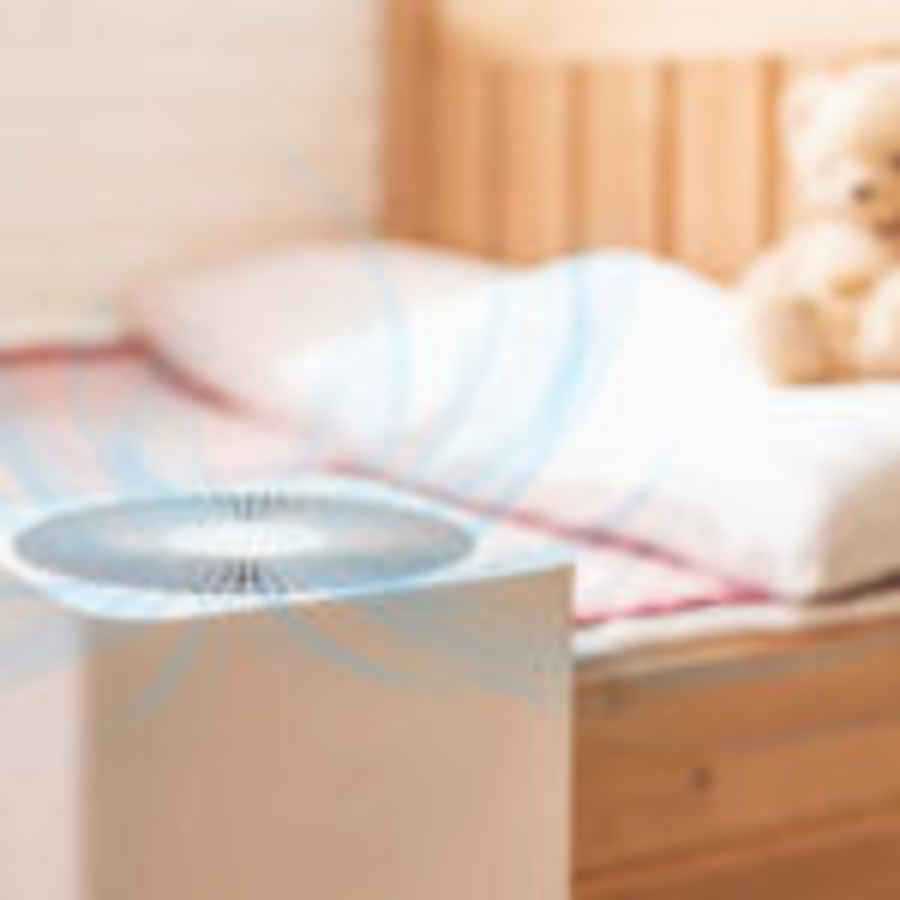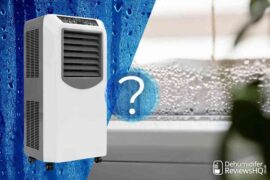The tumble dryer was once used frequently by homes across the nation. But, with energy prices relentlessly climbing year-on-year the tumble dryer is falling out our favour with many UK households. This energy-hungry appliance costs an average of around £0.35 an hour to use and people are looking for a cheaper alternative to dry their clothes indoors.
Surprisingly this need is being filled by the humble dehumidifier. Typically viewed as an appliance only suitable to tackle damp and condensation, many modern units are being furnished with a surprising array functionality, expanding their usefulness across the home. This coupled with their relativley low running costs means they are beginning to become the go-to appliance for drying clothes.
In this guide, we’ll look at how a dehumidifier could replace your tumble dryer, show you our recommendations of suitable appliances and look at how a dehumidifier stacks up to other methods of drying your clothes.
Laundry Mode
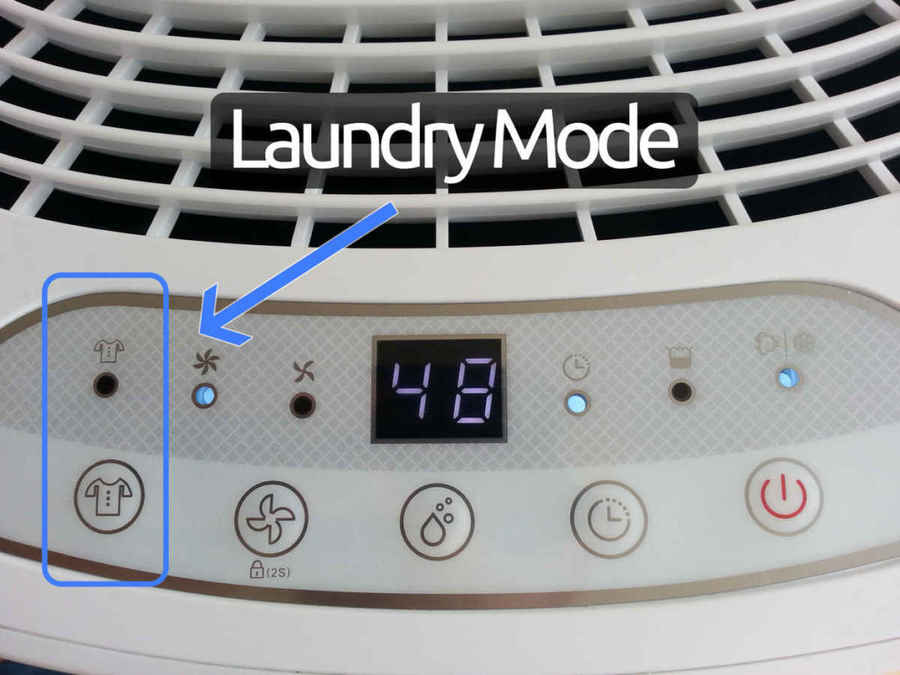 The most notable function on modern dehumidifiers is the inclusion of a specific laundry dry mode. Designed to dry loads of washing quickly this mode runs the dehumidifier at its highest fan speed and aims to lower the relative humidity to around 40%.
The most notable function on modern dehumidifiers is the inclusion of a specific laundry dry mode. Designed to dry loads of washing quickly this mode runs the dehumidifier at its highest fan speed and aims to lower the relative humidity to around 40%.
The fan is key in aiding the drying process because it not only pulls in moist air and drys it, but it also expels air that is, on average, 5°C warmer than the ambient temperature.
This means the high fan speed increases the warm airflow exiting from the machine. And, when this is directed towards washing, it helps it dry faster. The increased airflow also means the dehumidifier pulls in more air too. Ensuring the moisture created by the drying washing is sucked back into the machine and is safely collected. The end result is relatively fast drying without causing condensation or clammy air.
All but the most basic dehumidifiers now feature a laundry dry mode and when it comes to drying washing indoors this is the main feature you should look for in a dehumidifier.
How Does A Dehumidifier Compare To a Tumble Dryer?
We already know that a dehumidifier costs significantly less to use than a tumble dryer. But how much less? And, how effective are they at drying clothes compared to a tumble dryer?
Running Costs
 To answer the first question we first need to reintroduce the 3 main types of dehumidifier you’ll find available to the home market.
To answer the first question we first need to reintroduce the 3 main types of dehumidifier you’ll find available to the home market.
The first is refrigerant (also known as a compressor) dehumidifiers. This kind of dehumidifier is by far the cheapest to operate. In many cases costing as little as 1.5 – 3p an hour to use. Typically they are also the most robust of dehumidifiers and can withstand heavy use for many years. However the compressor pump also makes them the heaviest and least portable, and they can often weigh in excess of 10Kg.
The second is desiccant powered dehumidifiers. These are slightly more costly to operate coming in at around 3 – 6.5p/hour. However, the slightly higher running cost does come with an advantage. Desiccant units are very good at warming the room they operate within and reduce the need for an external heat source to help your washing dry. They are also much lighter than refrigerant dehumidifiers and can weight as little as 6Kg.
Lastly is Peltier based dehumidifiers. These are the least common kind of dehumidifier and typically can only be found in a handful of units. We wouldn’t recommend these for drying washing. Many domestic units lack not only the power to do this but also a sufficiently sized water tank to collect the water produced from a load of drying clothes in one go.
Drying Time
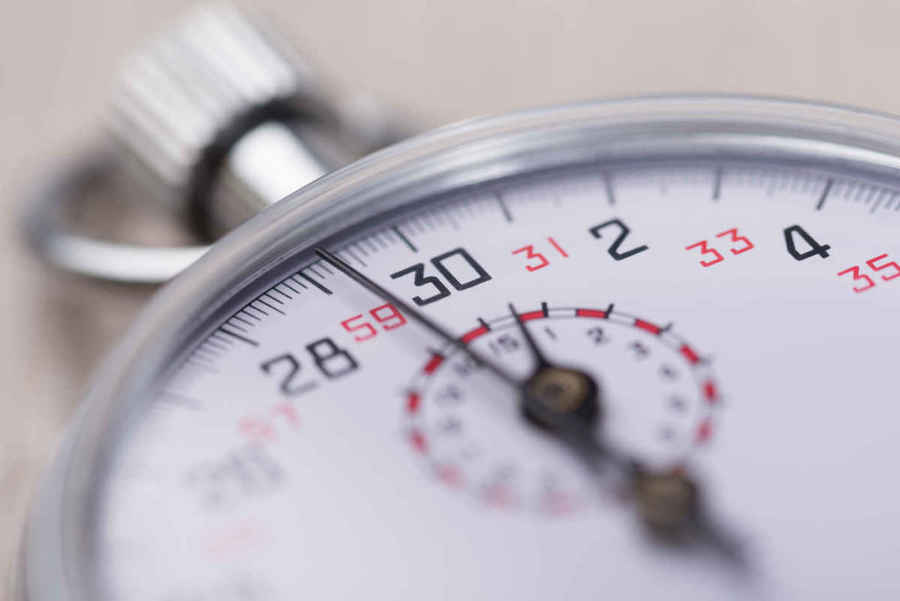 The time it takes dehumidifiers to dry your clothes is considerably longer when compared to a tumble dryer. Typically a tumble dryer can dry an average-sized load in about an hour. However, it can take 3-5 hours for a dehumidifier to do the same job.
The time it takes dehumidifiers to dry your clothes is considerably longer when compared to a tumble dryer. Typically a tumble dryer can dry an average-sized load in about an hour. However, it can take 3-5 hours for a dehumidifier to do the same job.
But, the big question is: is this a major disadvantage? We would say not.
So, Which is Better?
A dehumidifier may take longer. But with running costs as little as around 4.5p/hour (on average) it will still cost less than using a tumble dryer to achieve the same result.
In addition, the heat generated by a dehumidifier is not wasted, it is vented back into your home. In many cases (especially with desiccant units) a dehumidifier can heat an entire room, reducing the need for any other heat sources.
Lastly, a dehumidifier will help lower the overall humidity within your home helping to prevent condensation and making your home easier to heat because damp air is not as easy to heat as dry air. All-in-all a dehumidifier is an excellent alternative to a tumble dryer.
Our Recommendations:
25L Dehumidryer

With more specialist clothes drying features than any other dehumidifier the 25L is the first dehumidifier designed for the express purpose of drying washing quickly and cheaply. But, that doesn’t mean to say it doesn’t work well as a traditional dehumidifier. It is equally adept at tackling damp and condensation around the home.
When it comes to the 25L there are 3 key things that sets it apart from the competition when it comes to drying washing:
- DC motor – the harder you work a DC motor the less energy it uses. This means you can get the power you need to dry your washing without the 25L consuming vast amounts of energy.
- Large collection tank – within the 25L is a capacious 5L water collection tank. This will easily dry 2-3 loads of washing between empties. Making the 25L very hands-off to use.
- Powerful airflow – airflow is key in drying washing and helping it smell fresh. The 25L pushes out a whopping 280m/3 of air an hour. This is akin to drying your washing in a gentle breeze.
The 25L is designed to dry washing – a job it does very well. You can find out more about this powerful appliance in our full review.
- BEST LARGE LOW ENERGY DEHUMIDIFIER - The Meaco 25l Ultra Low Energy is a multi-award...
- DESIGNED FOR UK CLIMATE - Specifically developed with specifications to handle the unique...
- INTELLIGENT DESIGN - Packed with excellent features that make it stand out against...
Prices & information last updated on 2024-10-30
EcoAir DD1 MK5 Classic

Featuring powerful drying modes and a specific laundry dry mode the DD1 MK5 classic is more than suitable for drying washing. When this is coupled with its unique 3D motorised louvre (that can direct airflow precisely where it is needed) it is an effective alternative to using a tumble dryer. And, whilst the tank size isn’t as large as the Dehumdryers huge 5L tank it is still a very respectable 2L.
With the MK5 you get the benefits a high priced desiccant unit with all the key features you need to dry washing but, in a mid-priced model.
We reviewed the DD1 MK5 indepth here if you’d like to find out more about the general functioning of this dehumidifier and what other useful features it has.
- 3D-Louvre enables you to channel airflow over a Wide area or Spot to optimise efficiency...
- Powerful extraction of up to 7.5 Litres of moisture at cold temperatures as low as 1 ºC.
- Ideal for floor area up to 60 m².
Prices & information last updated on 2025-02-11
Meaco Zambezi

Much like the DD1 and Dehumidryer the Zambezi features a specific laundry dry mode, however the Zambezi’s laundry dry mode features some additional smart-tech that makes it not only efficient at drying laundry, but also energy-efficient too.
Meaco refers to this as their Laundry+ system. It means the unit is only actively removing moisture from the air when needed. However, even when its not collecting moisture from the air, the fan keeps running to keep the airflow needed to help dry your washing. This system is so effective that Meaco claims the Zambezi uses 600 watts less electricity when compared to other similar dehumidifiers.
You can find out more about the Zamebezi in our full review.
- EFFECTIVE MOISTURE MANAGEMENT- Possibly the world's best domestic low power dehumidifier,...
- 6 WORLD FIRSTS - The first domestic desiccant low energy dehumidifier to have: a digital...
- TACKLES ALL ENVIRONMENTS - Anywhere you have a damp or condensation problem, from the home...
Prices & information last updated on 2024-07-27
Runners up
With so many effective dehumidifiers available it was difficult to whittle our list down to the top 3. But, if you’re still unsure about the list above we recommend looking at:
The MeacoDRY ABC range. The ABC isn’t the powerhouse of a unit like those shown above. But it features a pretty decent laundry dry function and allows you get the high build quality of a Meaco dehumidifier but at a budget price.
You should also consider the DD122 mini. You can think of this as a slightly lower-powered version of the MK5 classic. But, this comes with the obvious advantage of a lower price tag. So, if you’re interested in the MK5, but want something a little cheaper, the DD122 should not disappoint.
Is Using a Dehumidifier to Dry Clothes Better Than Using A Radiator?
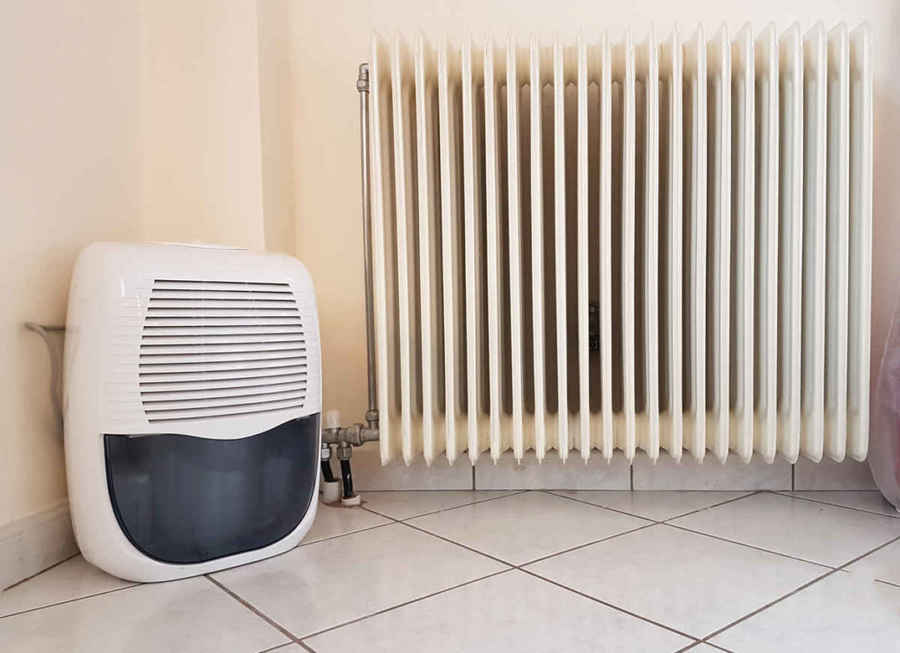 When its raining or cold and we can’t dry our clothes outside many of us resort to using our radiators to dry clothes. But this method of drying comes with a few caveats that can cause not just problems for our homes, but also our health, if done too often.
When its raining or cold and we can’t dry our clothes outside many of us resort to using our radiators to dry clothes. But this method of drying comes with a few caveats that can cause not just problems for our homes, but also our health, if done too often.
The first problem is that it significantly increases the relative humidity (RH) within our homes. Normally this isn’t a problem during the warmer times of the year. Open windows and doors allow any excess humidity to escape. However, when its cold and are windows are closed this humidity can’t escape and damp related problems can begin.
The first noticeable sign of high humidity is condensation. This can appear on walls, windows and any other cool surface within the home. When warm air contacts a cold surface its ability to hold its water content is vastly reduced and it is released as condensation.
The second problem is that overtime consistently damp and warm conditions provide the ideal breeding ground for bacteria and mould. This not only damages paintwork, silicone and grout but it can also be bad for our health.
Mould growing on a surface is, in itself, not harmful to us. However, it can be harmful to us when it ‘comes to seed’ and releases spores into the air. Sometimes this can induce respiratory problems when we inhale the spores and, in worst cases, lead to infections.
A dehumidifier will overcome these potential problems. Firstly it will lower the overall humidity within your home – making it much more difficult for condensation to form. And, secondly, some feature anti-bacterial filters that will kill spores and mould on contact – essentially cleaning the air you breathe.
Features To Consider:
Choosing a dehumidifier for drying your clothes is much the same as choosing a dehumidifier for dealing with damp. However, we’d ensure the dehumidifier you choose has the following features at a minimum because they are ideally suited for drying clothes.
Motorised Louvre
 Mounted on the top or front of many dehumidifiers is a louvre. Often appearing like a set of fins, they are located over the outlet air vent. Many can be manually moved to direct the air flow from the dehumidifier towards a particular spot.
Mounted on the top or front of many dehumidifiers is a louvre. Often appearing like a set of fins, they are located over the outlet air vent. Many can be manually moved to direct the air flow from the dehumidifier towards a particular spot.
Automatic louvres can be set direct this airflow in a continually sweeping arc ranging from 30deg; up to 180° in some cases. The advantage this provides is that is can automatically push air over the entirety of your washing when it is on a clothes horse. This ensures even and fast drying.
Extraction Rate and Water Tank Size
A larger water tank is a must when it comes to drying. Too small a tank and you won’t be able to dry a full load of washing without emptying it. That said, many of the 4l+ dehumidifiers come with an equally large price tag. So, if your budget is a little more modest you can find some very reasonably priced units with 2-3L tanks. At a minimum, we would recommend a 1.8L tank size.
The extraction rate refers to the amount of water a dehumidifier can remove from the air over 24 hours. This figure can often be confusing as manufacturers often quote huge figures such as 20L or 25L of water per day.
This is a little misleading because these refer to maximum water extraction in ‘ideal conditions’. To get these kinds of results many manufacturers test their dehumidifiers in humidity conditions of around 80% RH and at temperatures of 30°C – conditions you will rarely find in the average UK home!
With this in mind don’t feel you need a veritable power-house of a unit to dry your washing. A dehumidifier rated at (a more realistic) 7 or 8L of water per day will be more than capable of doing the job.
To Sum Up
Dehumidifiers aren’t the one-trick appliance they once were. Smarter tech and lower running costs mean they are gaining favour with many households and replacing the jobs carried out by bulkier, most costly appliances of recent years.
So if you’re on the fence about buying a dehumidifier to dry your washing, don’t be. They are just as effective as tumble dryers and much cheaper to run too.





